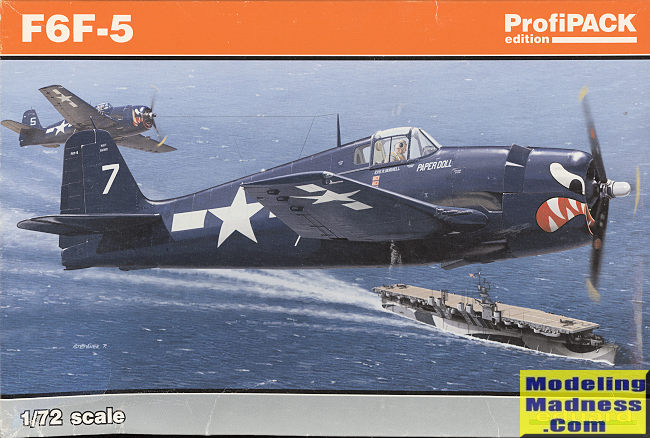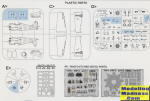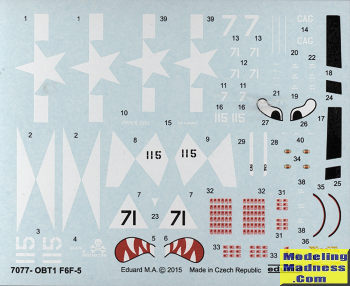
Eduard 1/72 F6F-5 'Hellcat'
| KIT #: | 7077 |
| PRICE: | $10.00 'used' |
| DECALS: | Four options |
| REVIEWER: | Scott Van Aken |
| NOTES: | Profipack |

| HISTORY |
The Grumman F6F Hellcat is an American carrier-based fighter aircraft of World War II. Designed to replace the earlier F4F Wildcat and to counter the Japanese Mitsubishi A6M Zero, it was the United States Navy's dominant fighter in the second half of the Pacific War, providing more carrier-based squadrons than the faster Vought F4U Corsair. The F4U was kept off fleet carriers for a considerable time due to it being a more tricky aircraft to land aboard ship. When the F6F was firmly entrenched, it was decided to limit Corsair fleet units in order to reduce strains on the supply chain. The Hellcat was providing great service, was easier to fly and land, so why mess with a good thing.
Powered by a 2,000 hp (1,500 kW) Pratt & Whitney R-2800 Double Wasp, the same powerplant used for both the Corsair and the United States Army Air Forces (USAAF) Republic P-47 Thunderbolt fighters, the F6F was an entirely new design, but it still resembled the Wildcat in many ways. Some military observers tagged the Hellcat as the "Wildcat's big brother".
The F6F made its combat debut in September 1943, and was best known for its role as a rugged, well-designed carrier fighter, which was able to outperform the A6M Zero and help secure air superiority over the Pacific theater. A total of 12,275 were built in just over two years.
Hellcats were credited with destroying a total of 5,223 enemy aircraft while in service with the U.S. Navy, U.S. Marine Corps, and Royal Navy Fleet Air Arm. This was more than any other Allied naval aircraft. Postwar, the Hellcat was phased out of front-line service, but remained in service as late as 1954 with the Naval Reserves and in various test programs. It was especially useful as a drone.
| THE KIT |
 Modelers
have never really been lacking in kits of the Hellcat in this scale. Airfix,
Frog, Hasegawa, and Academy have all had pretty good kits of this plane in 1/72.
This one adds a bit more detail than those other kits and it manages to correct
some of the small shape issues some of those kits have had.
Modelers
have never really been lacking in kits of the Hellcat in this scale. Airfix,
Frog, Hasegawa, and Academy have all had pretty good kits of this plane in 1/72.
This one adds a bit more detail than those other kits and it manages to correct
some of the small shape issues some of those kits have had.
 This is the
Profipack release which means you get a pair of photo etch frets. One is for the
cockpit and the other includes things like an engine wiring harness and fins for
the bombs. These frets along with the increased number of decal options and a
set of canopy masks are what make this sort of kit desirable. Of course if you
don't like p.e., then you need the weekend edition. However, since the bomb fins
are on the p.e. fret, you don't get to add the bombs.
This is the
Profipack release which means you get a pair of photo etch frets. One is for the
cockpit and the other includes things like an engine wiring harness and fins for
the bombs. These frets along with the increased number of decal options and a
set of canopy masks are what make this sort of kit desirable. Of course if you
don't like p.e., then you need the weekend edition. However, since the bomb fins
are on the p.e. fret, you don't get to add the bombs.
Most of the p.e. is for the cockpit so a considerable number of steps are provided in the instructions for that. Since early F6F-5s had the rear quarter windows of the -3, and two options are early planes, you need to decide if you are going to go that route and if so, you'll need to mask these. Otherwise simply paint over them. If using the centerline tank, open the fuselage holes for it. Wings are upper and lower halves with a gun insert that gets trapped between them. Eduard has decided for you that you'll use the rockets so you'll have to fill in those holes if you are not.
Once you've installed the horizontal stabs, it is time to assemble the engine. This fits into a three piece cowling which then attaches to the front of the fuselage. Landing gear is quite nicely done, and you can hold off installing them until after painting if you wish. However, the gear were generally the same color and the aircraft so your choice. The bomb racks are butt joins and you have a choice of two different sizes. The single piece prop just glues on the front. Finally, you have a choice of open or closed canopies.
 Instructions
are well done and provide detail images when needed. You get four overall gloss
sea blue options. One is David McCampbell's Minisi III while another is a cat
mouth VF-27 plane. These are early planes with the rear quarter windows. A third
is from VF-83 with the USS Essex in April 1945 while the fourth is with VF-20
aboard the USS Enterprise in late 1944. Three of these options have victory
markings. The Eduard decals are nicely printed, though when you look at the
sheet, the red bits are pink. I'm sure they will darken when put on the model.
I've also had less than positive results from Eduard's decals. I did the weekend
edition of this kit and had problems with silvering and lack of conformity
(setting solutions did not work). Aftermarket markings are out there.
Instructions
are well done and provide detail images when needed. You get four overall gloss
sea blue options. One is David McCampbell's Minisi III while another is a cat
mouth VF-27 plane. These are early planes with the rear quarter windows. A third
is from VF-83 with the USS Essex in April 1945 while the fourth is with VF-20
aboard the USS Enterprise in late 1944. Three of these options have victory
markings. The Eduard decals are nicely printed, though when you look at the
sheet, the red bits are pink. I'm sure they will darken when put on the model.
I've also had less than positive results from Eduard's decals. I did the weekend
edition of this kit and had problems with silvering and lack of conformity
(setting solutions did not work). Aftermarket markings are out there.
| CONCLUSIONS |
Aside from the possible decal issues, this is a very nice kit. It provides a higher level of detail than the others and you'll end up with a super looking model when done.
| REFERENCES |
https://en.wikipedia.org/wiki/Grumman_F6F_Hellcat
November 2020 Copyright ModelingMadness.com. All rights
reserved. If you would like your product reviewed fairly and fairly quickly, please
contact
the editor or see other details in the
Note to
Contributors. Back to the Main Page
Back to the Review
Index Page
Back to the Previews Index Page